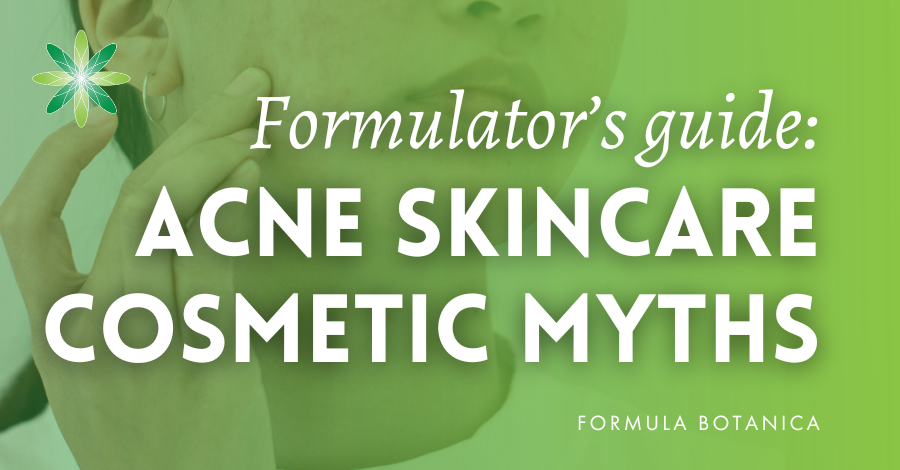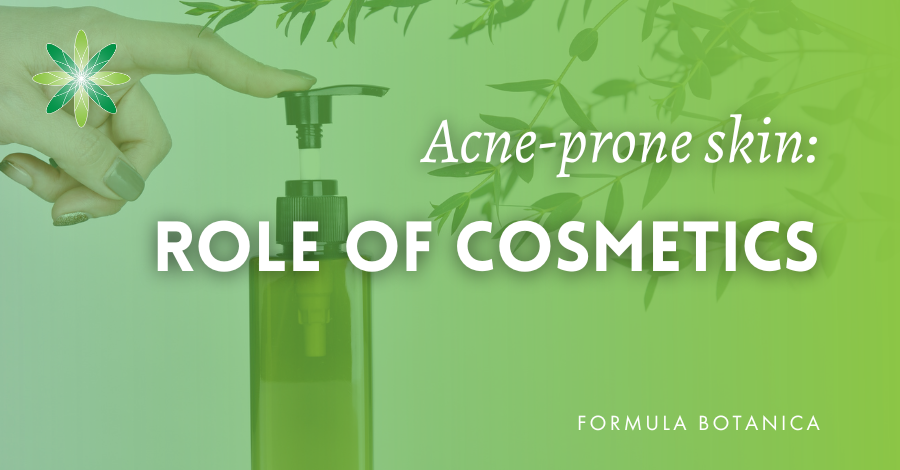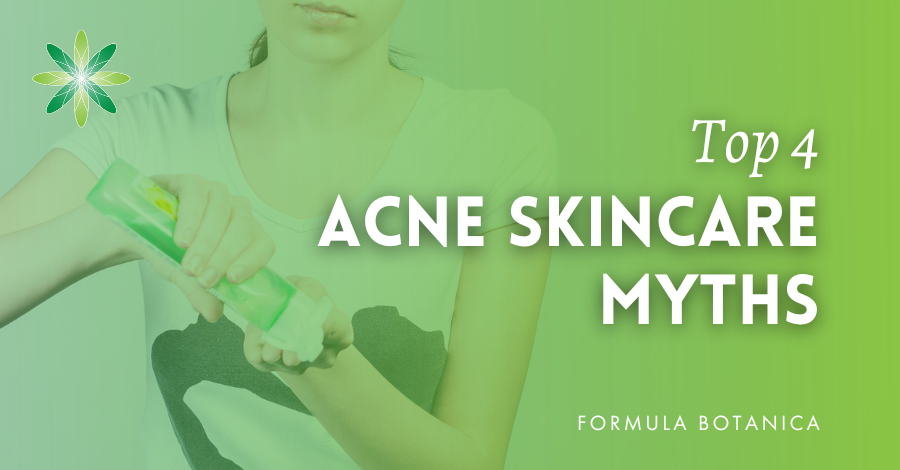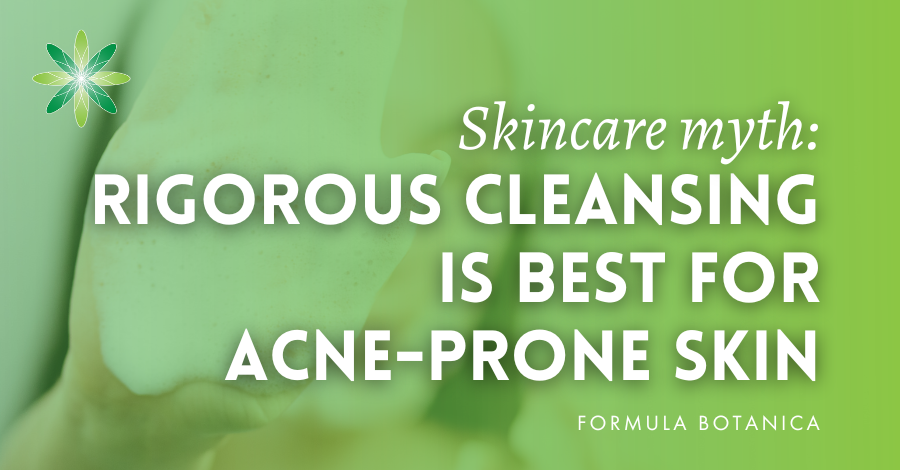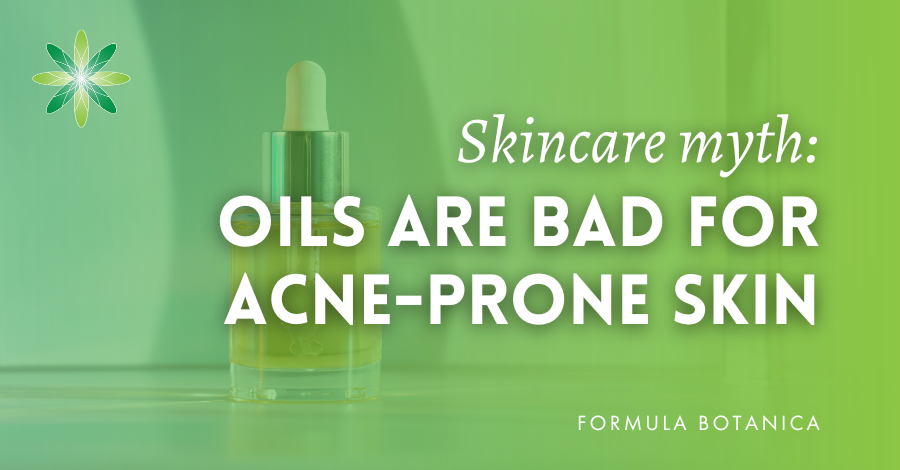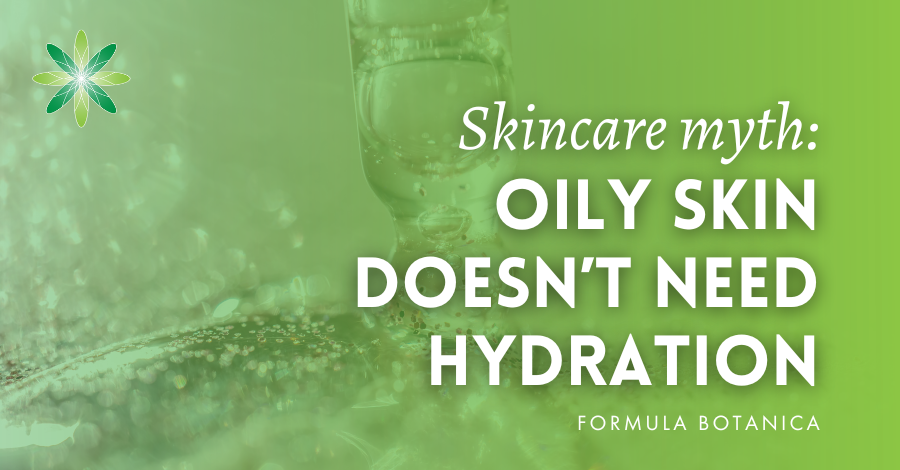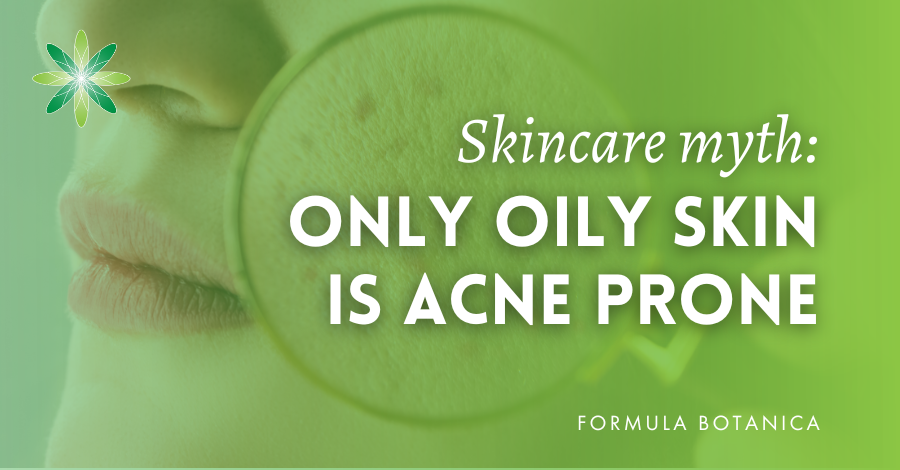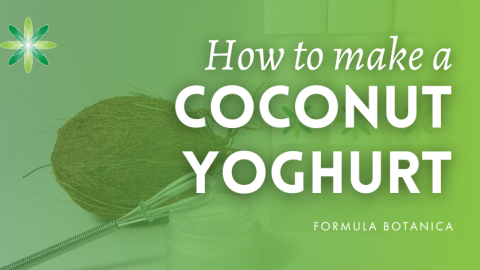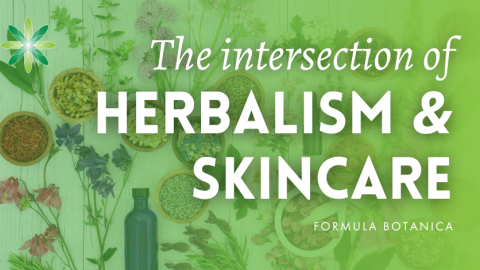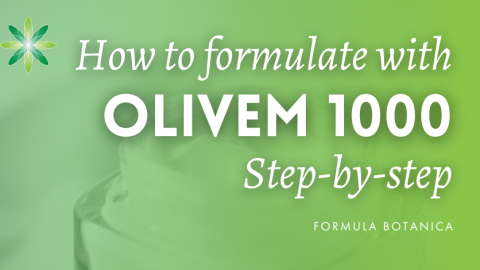Many people have issues with blemishes, outbreaks, congested pores, and excessively oily and acne-prone skin. Browse in drugstores or online and you will find cosmetic formulations aimed at some of these – not acne though, for reasons we’ll see later. It is understandable that as a natural cosmetic formulator, you too may be keen to create skincare to address these common, everyday skin issues.
Tempting as it may be to formulate to alleviate their effects and mitigate their visible signs, there are several critically-important things to know about the topic of blemish- to acne-prone skin. There is plenty of misleading information about what cosmetics can and cannot do for these skin concerns, especially acne, among the general public, in the beauty media and circulating on social media.
The aim of this post is to clarify the role of cosmetics in targeting these skin issues so that as a natural cosmetic formulator you can take the best approach to devising safe, gentle and effective formulations for yourself, friends, family or customers.
You’ll find out what acne is and its most common causes, and learn about the four main acne skincare myths circulating in beauty circles. We also suggest natural ingredients to explore in your formulations aimed at skin prone to blemishes and outbreaks or with acne as a dermatological condition.
What is acne?
While most people have heard of acne, not everybody knows what acne is. Acne vulgaris, commonly known as acne, is a chronic inflammatory skin condition that occurs when the hair follicles under the skin become clogged (i). Most often it manifests on the face, neck, chest, or back.
Acne can occur both during adolescence and adulthood and is characterised by excess sebum production, sebum retention, and ultimately, inflammation. This inflammation can transform into a scar. Acne can play a huge part in someone’s daily life, and people who have acne can suffer from both its negative physical and psychological effects (ii, iii).
Most common causes of acne
The mechanisms of acne are complex as they depend on multiple factors and can vary from person to person. However, the most commonly-accepted factors include increased sebum production due to androgen hormones, abnormal keratinisation, inflammation, and bacterial colonisation of hair follicles by Cutibacterium acnes (C. acnes), often caused by a disturbed skin barrier and imbalance of the skin’s microbiome (iv, v).
Another trigger for acne could also be lifestyle factors such as smoking, stress and diet. More research needs to be done on the causes of acne, especially on the relationship between acne and diet (vi), as it is still unclear what exactly triggers acne.
What can cosmetics do for acne?
Before we dive into the myths, let’s recap on the role of cosmetics when applied to acne-prone skin. It is vital to understand that cosmetics, by their very definition, are topical preparations applied to the body or face to improve its appearance.
The key word here is appearance. Cosmetics do not treat nor cure dermatological conditions nor claim any medical function. If they were to, they would need to undergo clinical trials and be rigorously assessed and controlled as medicines or pharmaceuticals.
Dermatology is a branch of medicine concerned with the diagnosis and treatment of skin disorders. Acne, along with conditions like eczema and dermatitis is a dermatological condition.
As natural formulators, our role is to improve the appearance of the skin through the topical application of cosmetics. Our formulation ingredients do have a role to play, such as mitigating the visible signs of oily skin, congested pores, and blemishes and in helping calm inflammation. What our cosmetics certainly cannot do is treat, eradicate or cure the causes or effects of acne or the inflammation it causes.
If you wish to formulate for blemish- or acne-prone skin, don’t despair; there are plenty of ways to do so as you’ll now find out. We gave you some hints earlier when we talked about the skin barrier and the skin’s microbiome.
Top 4 acne skincare myths
Nowadays, most people turn to the internet or mainstream media to further their knowledge on skincare, which explains why there are so many misconceptions about this common skin condition (viii).
It can be hard to distinguish fact from fiction, especially with the overwhelming amount of information about acne products and ingredients. In the section below, we debunk the four most common myths and misconceptions about acne skincare (ix, x).
Myth 1. Rigorous cleansing reduces acne, blemishes and excessive oil
Many people believe that rigorous and frequent face washing can reduce acne, yet there is no direct evidence to suggest a link between facial cleanliness and acne. Excessive cleansing can actually be detrimental to acne- and blemish-prone or oily skin, as it can impair the skin barrier by stripping away its beneficial microorganisms.
Over the last few years, there has been an increased awareness of the skin microbiome; the ensemble of microorganisms living in your skin, consisting of bacteria, fungi and viruses (xii). While the science of the skin microbiome is still very young, we know that the skin microbiome protects and maintains skin health. However, many factors can influence the microbiome and cause an imbalance, such as genetics, lifestyle, diet, and environment.
Solution: formulate for the skin microbiome
If you want to formulate for blemish-prone, acne-prone or oily skin, remember that less is more. Skincare shouldn’t interfere with your skin’s natural microbiome. However, certain ingredients can disturb the skin’s microbiome or impair the skin barrier such as harsh surfactants, emulsifiers, and essential oils. Another factor to pay attention to in formulating for the skin barrier is the pH level of your formulation.
Seek out milder alternatives for your formulations that demonstrate good skin compatibility and cause less irritation than, for example, ingredients such as traditional, sulphate-based surfactants. Remember also that it is not so much about individual ingredients, but rather about the synergy of these ingredients.
Excessive sebum may be removed by using mild, non-irritating surfactants, such as cocamidopropyl betaine, coco glucoside and decyl glucoside, in low concentrations. You may also formulate gels and solutions with antimicrobial ingredients and mild exfoliants (these exfoliate the epidermis and may prevent the formation of blemishes).
If you want to learn more about the skin’s microbiome, check out our mini course on it on our membership site, The Lab at Formula Botanica. You can also learn more about this topic in our podcast episodes:
Episode 161: Microbiome skincare- is it really a thing?
Episode 162: The gentle skincare revolution-rethinking formulation
It is pertinent here to mention also the role of the beta-hydroxy acid (BHA) category of liquid exfoliants which are often used on blemish- and acne-prone skin.
Salicylic acid is a well-known BHA used to mitigate the effects of acne as well as actinic patches (skin that develops rough, scaly patches from long-term UV exposure) and pigmented skin.
As lipid-soluble compounds, BHAs are more suited to oilier skins as they slough off the dead epidermal cells traveling through the skin’s sebum. They are best used at around 1-2 per cent concentration. In addition, BHAs also provide anti-inflammatory properties, which we discuss in myth 4 below. For in-depth understanding of liquid exfoliants – both AHA and BHAs – see our post:
Myth 2: Oils are bad for acne-prone and oily skin
One of the most common myths about blemish-prone, acne-prone and oily skin is that oils can make the condition worse. Skin conditions like acne may occur when the ratio of lipids and fatty acids in your skin is out of balance. The common reaction to this is to avoid all oils at all costs in order to “dry out” the skin and remove any excess oil.
There is a belief that certain cosmetics are more comedogenic (blemish and breakout inducing) than others. However this is a misconception. In the 1970s, people were concerned that their cosmetics were causing acne and breakouts, and beauty brands began to market their products as “oil-free”. Scientists also developed a system to test the comedogenicity of certain cosmetic ingredients using rabbits’ ears.
However, apart from the ethical problems of those tests, there were many concerns about the methodology itself. Rabbit ear skin is not akin to human skin. Nowadays, scientists test ingredients on the back skin of humans, but this method is also inconclusive.
When formulating skincare for blemish- and acne-prone skin, you shouldn’t rely on the comedogenic scale, but focus rather on individual skincare needs instead. And while you should avoid using certain oils, like palmitoleic or oleic acid, if you have these skin conditions, some oils like linoleic and palmitic acid can help restore your skin’s natural pH balance.
Solution: formulate with the right balance of oils
A good approach therefore is to provide the missing fatty acids instead and reduce the intake of monounsaturated fatty acids until the skin’s balance is restored.
When formulating for problematic skin, select one or multiple oils to supply the skin with what it is missing. Topical applications of these oils can help to increase cell membrane fluidity, enhance the skin’s barrier function, decrease trans-epidermal water loss (TEWL), and improve moisturisation and anti-inflammatory activity. Oils high in linoleic acid such as cucumber oil, passion fruit oil, or evening primrose oil are particularly beneficial for blemished skin.
Learn more about the compounds within and the role of some common useful botanical oils in our articles:
Why you need seed oils in your skincare and haircare
Top 10 botanical oils every formulator needs
Myth 3: Acne-prone and oily skin don’t need hydration
Another common myth is that acne-prone and oily skin do not require hydration. In fact, the opposite is true. Appropriate skin hydration is vital to preserve the skin’s barrier function, which is essential to your skin’s health.
When the skin barrier is impaired, it can lead to water loss. This impairs the skin’s natural process of exfoliation (known as desquamation), as the enzymes that control it become deactivated when they can’t reach proper hydration levels. One effect of skin dehydration is the build-up of an excess of dead skin cells inside the hair follicles that may cause the pores to clog, leading to blemishes.
An impaired skin barrier can also provoke an immune response such as inflammation associated with acne. This inflammatory response may be caused by lifestyle choices and certain skincare ingredients like emulsifiers, surfactants, and active ingredients, as well as some ingredients that act as penetration enhancers. People may think they have “bad” skin when in fact they’re dealing with constant inflammation and irritation due to ingredient incompatibility within and among the different cosmetic products they use.
Solution: formulate suitable hydrating products
There are plenty of options for formulating light, hydrating products adapted to the needs of blemish- or acne-prone or oily skin using gentle moisturising ingredients to help restore the skin’s barrier function.
Options include formulating light products like hydrating gels and using light oils and emollients if making emulsions. It is advisable not to formulate with more occlusive oils and butters when targeting oily skin, as they can feel heavy.
The three key hydrating ingredients to help restore and maintain your skin’s barrier are humectants, occlusives and emollients (xiii). We recommend you combine these three ingredient categories for best results. Find out more about the skin barrier in our post:
Skin barrier 101: essential guide for natural cosmetic formulators
Myth 4: Only people with oily skin get acne
One persistent myth is that only people with oily skin have acne, when in fact many skin types can have acne-prone skin. Our comprehensive post on the concept of skin types explains that our “skin type” today is likely to change even within a few months as factors affecting it are constantly fluctuating.
For example, acne breakouts known as acne cosmetica may occur when you use the wrong skincare products or makeup for your skin. Sometimes, these breakouts manifest as follicular inflammation, which can often look like acne.
So, categorising ourselves into rigid skin types oversimplifies the complexity of how our skin functions and the diversity of possible skin conditions. Our post is a good place to start before reading on about acne:
As said previously, acne is an inflammatory disease. It can affect anybody, and the causes vary from person to person. Acne develops in the sebaceous follicles, and increased sebum production and abnormal keratinisation lead to clogged hair follicles, which in turn lead to the formation of comedones, also known as pimples.
Inflammation is key to any type of acne lesions, and using anti-inflammatory products may help reduce this immune response. Emerging data shows that inflammation may occur at all stages of acne development, with immunochemical pathways that initiate and propagate the inflammatory response (xiv). The causes of inflammation are very complex and still require more research, but may involve the colonisation of PC. acnes.
Solutions: formulate with anti-inflammatory ingredients
Anti-inflammatory ingredients can help alleviate breakouts. There are plenty to choose from in the wonderful world of natural cosmetics. Certain cold-pressed plant oils and unrefined butters help soften and soothe the skin, such as argan oil, babassu oil, hemp oil, cocoa butter, cupuaçu butter, kombo butter, shea butter, and so much more. Borage oil, for example, is well known for its anti-inflammatory properties.
For a more high-performance formula, you can include plant extracts and active botanicals such as calendula or German chamomile, which is high in alpha-bisabolol, a powerful anti-inflammatory compound.
Other anti-inflammatory ingredients include vitamin B3 (niacinamide) and vitamin C as well as aloe vera, green tea and rosemary extracts.
Adding certain essential oils can also be beneficial in acne formulations, as they can help reduce inflammation and reduce acne scars. Make sure you respect their dermal limits in your formulation, as certain essential oils contain allergens.
If you are a more advanced formulator, why not blend anti-inflammatory ingredients with a natural retinol alternative? Research has shown that combining a retinoid with an anti-inflammatory may help reduce inflammation in acne-prone skin (xiv).
Formulate your future
Formulating is an incredibly powerful tool. You could even build your skincare brand around certain skincare concerns. If you choose to sell your cosmetics, be careful in how you market them, as you can’t make any medical claims.
If you’d like to learn how to formulate and start a skincare business, check out our accredited courses. We advise taking our popular foundation course first – the Diploma in Organic Skincare Formulation – as a stepping stone to more advanced cosmetic formulation – and, who knows, a career- and life-changing path into natural formulation helping people with their skincare concerns.
References
(i) Williams et al, 2011. Acne vulgaris.
(ii) Hazarika et al, 2016. The psychosocial impact of acne vulgaris.
(iii) Hanna et al, 2003. Acne vulgaris: more than skin deep.
(iv) Beylot, 2002. Mechanisms and causes of acne.
(v) Harper et al, 2003. Pathogenesis of acne: recent research advances.
(vi) Pappas, 2009. The relationship of diet and acne.
(vii) Dréno, 2017. What is new in the pathophysiology of acne, an overview.
(viii) Brajac et al, 2004. Acne vulgaris: myths and misconceptions among patients and family physicians.
(ix) Magin et al, 2005. A systematic review of the evidence for “myths and misconceptions” in acne management: diet, face, washing and sunlight.
(x) Hui, 2017. Common misconceptions about acne vulgaris.
(xi) Human Microbiome Project Consortium, 2012. Structure, function and diversity of the healthy human microbiome.
(xii) L. Chularojanamontri, et al, 2014. Journal of Clinical and Aesthetic Dermatology, 2014. Moisturizers for acne.
(xiii) Lertsatitthanakorn et al, 2006. In vitro bioactivities of essential oils used for acne control.
(xiv) Emil A. Tanghetti, 2013. Journal of Clinical and Aesthetic Dermatology. The role of inflammation in the pathology of acne .
FREE TRAINING
Learn how to become an
Organic Skincare Formulator
FREE TRAINING
How to become an
Organic Skincare Entrepreneur
FREE TRAINING
How to become an
Organic Skincare Entrepreneur
Leave us a comment

Ariane is Formula Botanica’s Content Creator and an active member of the student community. She has worked as a professional journalist, blogger, copywriter and editor before joining Formula Botanica full-time in 2024.

